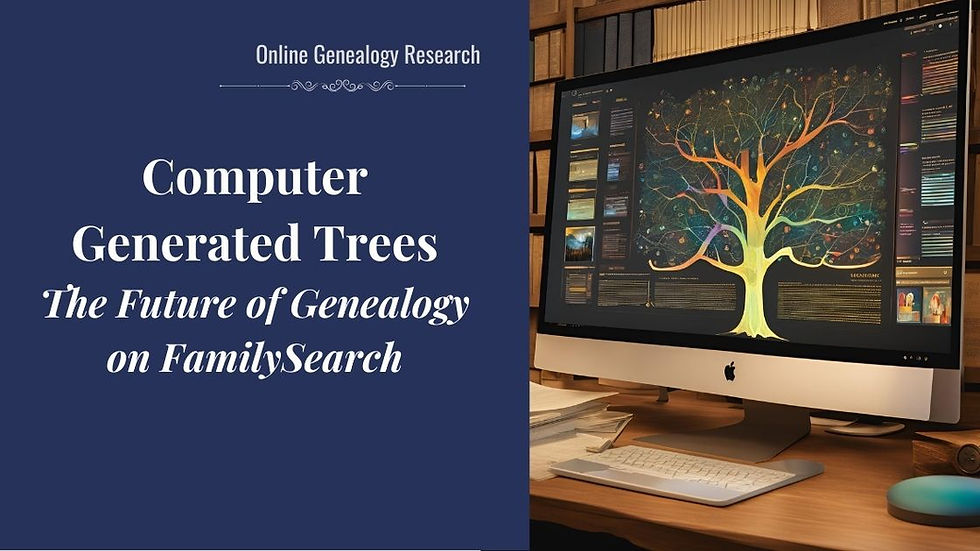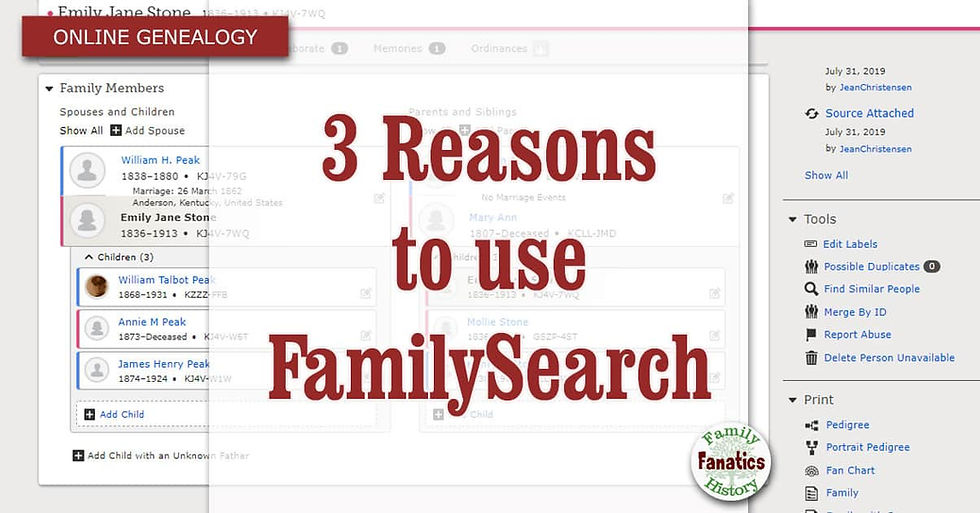Exploring the Future of Genealogy Research: FamilySearch Computer-Generated Family Trees
- Devon Noel Lee

- Jun 17, 2023
- 5 min read
Updated: Nov 11, 2024

The world of genealogy research is about to experience a groundbreaking transformation. In my quest to explore the latest advancements, I stumbled upon an incredible project on FamilySearch that will leave you in awe.
While you may not directly benefit from it, the sheer brilliance of this innovation will undoubtedly inspire you. So, stick around as I guide you through this remarkable journey.
Introducing FamilySearch's Computer-Generated Trees
For centuries, genealogy research has thrived in English-speaking countries like the United Kingdom, Canada, Australia, and the United States. However, many countries, particularly in South and Central America, Asia, and other parts of the world, have faced resource limitations when it comes to exploring their family history.
But now, FamilySearch has introduced a groundbreaking project called Computer-Generated Trees (CGTs), set to change the game.
To see these computer-generated trees in action, watch this video.
Breaking Down the Pedigree Chart
At first glance, the CGTs may not appear vastly different from a traditional pedigree chart. But in reality, FamilySearch has leveraged cutting-edge technology to scan and interpret millions of historical records. The result?
A meticulously constructed family tree for individuals living in specific locations and time periods. As you can see on the screen, locations like Italy, Australia, Brazil, the Philippines, and Mexico have already benefited from this revolutionary program.
A Separate Family Tree for a Deeper Dive
It's important to note that these computer-generated trees are separate from the main One World Family Tree. So, if you're a newbie genealogist or have ties to these five countries, I highly recommend exploring this resource.
Once you've built your initial family tree in the One World Family Tree, you can delve into the CGTs for a more focused and detailed exploration.
Putting it to the Test: Arcadio Hernandez's Story
To truly grasp the potential of the CGTs, I decided to put the tool to the test. I selected Arcadio Hernandez, a Nuevo Leon, Mexico resident, as my subject.
However, before diving in, FamilySearch warns that this feature's data accuracy is moderate. While the computer-generated tree might be right, user validation is necessary.
Exploring Arcadio's Computer-Generated Tree
Clicking on the computer-generated tree for Nuevo Leon and entering Arcadio's name, a world of possibilities unfolds. You'll discover various search options, each providing different levels of information. Some trees include parents, while others showcase spouses, children, and more. This is undoubtedly an exciting prospect for genealogists.
The Beauty of the CGTs Unveiled
By clicking through to Arcadio's tree, you're greeted with a traditional pedigree chart. This particular tree spans four generations, including children and Arcadio's wife.
As you click on each individual, the side panel dynamically updates, revealing the events and relationships compiled by the computer. Birth events, census records, and birth registrations all come together to paint a vivid picture.
Unveiling the Original Sources
Ever wondered about the sources behind the CGTs?
FamilySearch has got you covered.
Once you're signed in, scrolling down reveals a magical button labeled "View Sources."
Clicking on it grants access to a colorized spreadsheet that holds the key to the computer's decision-making process.
This feature truly showcases the power of spreadsheets in genealogy research.
Correlation with Record Linking and Super Family Projects
If you recall my previous video on the Record Linking Lab and the fascinating super family project of the 1880s, you'll notice a correlation with the concept behind the CGTs.
The computer gathers records that share commonalities in family names, dates, and locations, facilitating the segmentation of individuals into family clusters. The more detailed the records, the more successful the program becomes.
Although not flawless, this separation from the One World Family Tree ensures accurate suggestions.
Validating with Original Records
FamilySearch allows users to access the original records behind the CGTs to ensure accuracy and authenticity. You'll be redirected to the main FamilySearch Family Tree by clicking on a specific link, where you can validate the extracted information against the original source.
You can seamlessly attach the record to your family tree if it's a match. Plus, the system searches for potential matches within the One World Family Tree, expanding your connections and possibilities.
↪️ Are you looking for more genealogy resources?
Grab your copy of these FREE Genealogy Research Guides.
Expanding the FamilySearch Family Tree
A magical thing happens as you continue your journey through the CGTs, adding records to the One World Family Tree. Record hints start popping up in the research help section of a person's profile. This invaluable feature guides you in further expanding your family tree by suggesting additional relatives and connections.
One notable decision by FamilySearch is to keep the CGTs separate from the One World Family Tree. However, they do interact in terms of discoveries.
Once a CGT record is attached, it seamlessly merges with the One World Family Tree, promoting collaboration and validation. It's a thrilling prospect that sets the stage for a unified and comprehensive global family tree.
Unleashing the Power of Technology
For seasoned genealogists, this technology's true power and significance might be hard to fathom. However, having worked with various record hints for years, I can confidently say that this innovation is nothing short of revolutionary.
With the inclusion of locations like Mexico, the value of CGTs becomes even more evident. Catholic Church records, for instance, offer a wealth of information, and the computer program's ability to process numerous details within moments is awe-inspiring.
As I immersed myself in this extraordinary experience, I couldn't help but yearn for the technology to be available in the locations where my ancestors lived, like Gillershiem, Hanover, or all of Baden. The potential for CGTs to unlock hidden connections and reveal the tapestry of our ancestors' lives is truly exciting.
Explore and Share Your Thoughts
The future of genealogy research is upon us, and FamilySearch's Computer-Generated Trees are at the forefront of this exciting evolution. With its ability to scan and interpret historical records, this groundbreaking technology empowers individuals worldwide to delve into their family history.
Embrace this revolution, discover the power of CGTs, and unlock the secrets of your ancestors' lives. The possibilities are as vast as the branches on your family tree.
If you find this technology as captivating or even slightly daunting as I do, share your thoughts in the comments section below. Additionally, let me know which locations you'd like to see CGTs for in the future. The possibilities are endless!
Build Your Family Tree with FamilySearch
If you're ready to embark on your own genealogy journey, be sure to check out our articles on FamilySearch, which are filled with tips and tricks for building your family tree. Uncover the hidden gems of your heritage and connect with your roots like never before.

.png)




Comments